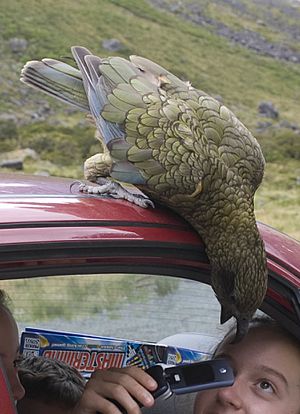Kea facts for kids
Quick facts for kids Kea |
|
|---|---|
 |
|
| Conservation status | |
| Scientific classification | |
| Kingdom: | |
| Phylum: | |
| Class: | |
| Order: | |
| Family: | |
| Genus: | |
| Species: |
N. notabilis
|
| Binomial name | |
| Nestor notabilis |
|
The kea is a large parrot that lives in the mountains and forests of New Zealand's South Island. It is about 48 cm (19 inches) long. This amazing bird is mostly olive-green. It has bright orange feathers under its wings. The kea also has a big, curved, grey-brown beak. It is the only alpine parrot in the world!
Long ago, people hunted kea because they thought the birds attacked farm animals. But in 1986, the kea became fully protected by law. Today, signs are put up to warn drivers about kea on the roads. This helps keep these special birds safe.
Kea make their nests in holes or cracks. These can be found among tree roots. Kea are very smart and curious birds. These traits help them survive in their tough mountain home. They can solve tricky puzzles to find food. They even work together to reach goals. Scientists have also filmed kea using simple tools.
The kea was featured on the New Zealand $10 note. It appeared on the back of the note from 1967 to 1992.
Contents
What's in a Kea's Name?
The kea was first described by a bird expert named John Gould in 1856. Its scientific name is Nestor notabilis. The word notabilis is Latin and means "noteworthy" or "remarkable."
The common name "kea" comes from the Māori language. It probably sounds like the bird's call when it flies – ‘keee aaa’.
There are four types of birds in the kea family. These include the New Zealand kaka, the extinct Norfolk kaka, and the extinct Chatham kaka. All these birds are thought to have come from an ancient parrot. This "proto-kākā" lived in New Zealand's forests millions of years ago. The kea's closest living relative is the kakapo, which cannot fly.
Kea and People: A Tricky Friendship
Kea love to explore and play with things. This makes them both a bit of a nuisance and a fun sight for tourists. People often call them "the clown of the mountains."
Kea will investigate backpacks, boots, skis, and even cars. They might cause damage or fly off with small items. In the past, some people kept kea as pets. But it was hard to catch them, and they could be very destructive.
You can often see wild kea at ski resorts in the South Island. They are drawn there by the chance to find food scraps. Their curiosity leads them to peck at clothes or pull apart rubber parts of cars. This can be both funny and annoying for people watching.
People often say kea are "cheeky." One kea was even reported to have taken a tourist's passport! This happened while the person was visiting Fiordland National Park.
Kea are social birds. They live in groups of up to 13 birds. A kea living alone in captivity does not do well. But they respond positively to seeing their own reflection in a mirror. The oldest known kea in captivity was 50 years old in 2008.
What Do Kea Eat?
Kea are omnivores, meaning they eat both plants and animals. They feed on over 40 types of plants. They also eat beetle larvae, other birds, and small mammals. These mammals include sheep and rabbits. There have even been reports of kea attacking dogs and horses.
Kea have been seen breaking open shearwater nests. They do this to eat the chicks inside. Kea also take advantage of human garbage and food given to them. Some people believe that eating human food is not good for the kea's health. It can give them an unbalanced diet.
Images for kids
-
A young kea chick at Weltvogelpark Walsrode, Germany.
See also
 In Spanish: Kea para niños
In Spanish: Kea para niños







